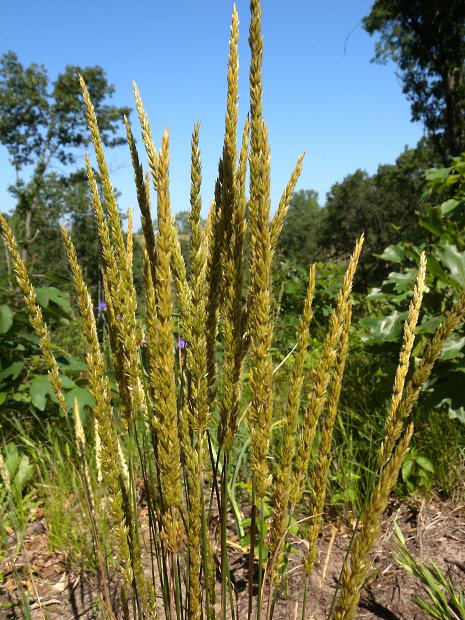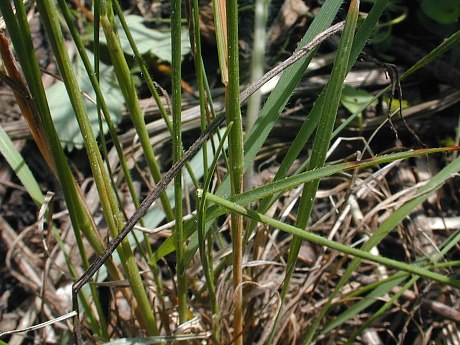Description: This perennial grass forms a tight tuft of culms and leaves about ½–1½' tall. The culms are light green, terete, and glabrous to finely pubescent. The alternate leaves are located mostly along the lower half of each culm. The leaf blades are up to 4.5 mm. across and 6" long; they are medium green to greyish blue, flat to somewhat involute (rolled inward), and slightly pubescent to hairless. The leaf sheaths are similar in color to the leaf blades and usually pubescent. There are remnants of dried leaves surrounding the base of each tufted plant; these dried leaves are light grey or straw-colored. Each culm terminates in a spike-like panicle of florets about 2-6" long. This panicle is initially light to medium green, but it later becomes light tan to various shades of brown.

The branches of this panicle are up to 1" long and appressed to ascending; they subdivide into branchlets with terminal spikelets. Each spikelet is 5-6 mm. long and somewhat flattened; it consists of a pair of glumes at the bottom and 1 or 2 pairs of lemmas. Each lemma has a palea that encloses a single perfect floret. The glumes and lemmas are ovate-lanceolate, keeled, and hairless. The lemmas and larger glume are 4-5 mm. long, while the smaller glume is 3-4 mm. long. The blooming period occurs during the late spring or early summer (hence the common name of the species). The florets are wind-pollinated. After the grains ripen, disarticulation is above the glumes. Individual grains are 2.5-3.0 mm. long, slightly flattened and ellipsoid in shape, and light-colored. The root system is fibrous and short-rhizomatous. June Grass normally occurs in scattered tufts, rather than forming dense colonies.

Cultivation:
In
Illinois, this grass is typically found on dry sandy ground where it is
sunny. It will tolerate more fertile soil if competition from taller
plants is reduced or eliminated. Under the preceding conditions, either
level ground or slopes provide acceptable locations. Because of the C3
metabolism of this cool-season grass, most vegetative growth and
development occurs during the spring and early summer.
Range & Habitat:
The native June Grass occurs occasionally in sandy areas of Illinois
(particularly in the northern and western sections of the state); it is
uncommon or absent elsewhere (see Distribution
Map). Habitats include dry sand prairies, hill prairies,
stabilized foredunes near Lake Michigan, upland sandy savannas, and
limestone glades. This conservative species is typically found in
higher quality natural areas. Sometimes it is used in prairie
restorations.

Faunal
Associations:
June Grass is one of the food plants of several grass-eating
grasshoppers, particularly those species that prefer dry habitats with
sparse vegetation (see Grasshopper Table).
Leafhoppers that use this grass as a food plant include Auridius
helvus and Rosenus cruciatus (Panzer et
al., 2006). Among vertebrate animals, the foliage of June Grass is
palatable to hoofed mammalian herbivores, including elk, deer, horses,
and cattle. However, because this grass is short in stature and rarely
forms dense stands, it provides only a minor component of the diet of
these animals.
Photographic Location:
A stabilized foredune near Lake Michigan at the Indiana Dunes State
Park in NW Indiana, and the wildflower garden of the webmaster in
Urbana, Illinois.

Comments: If other prairie grasses are too tall for your taste, this is one grass species to consider. It isn't very aggressive and greens up earlier in the year than Schizachyrium scoparium (Little Bluestem) and other warm-season prairie grasses. June Grass is the only species in its genus that occurs in the Midwest and it is fairly unique. Considering the size of this grass, its inflorescence is rather large and stout. There is some variability across local populations in the color and hairiness of the foliage; the color of the inflorescence can be variable as well. June Grass is more typical of the mixed-grass prairie of the Northern Plains than the tall-grass prairie in Illinois. An older scientific name of this species is Koeleria cristata.